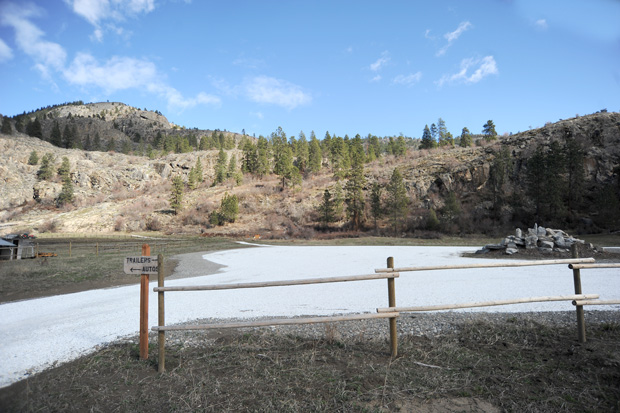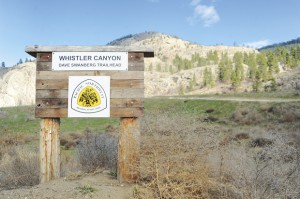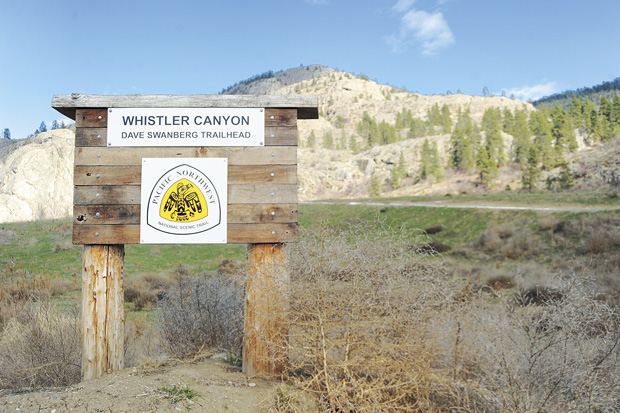

Once again I thank all those who donated to the ‘Save the Whistler Canyon Fund’ and special thanks to Echo Bay Minerals ‘Kinross Gold,’ Jon Knechtel, Director of Trail Operations, PNTA
Kinross purchases Whistler Canyon recreational property
OROVILLE – The latest newsletter from the Pacific Northwest Trail Association is expressing gratitude to Echo Bay Minerals for the purchase of property near the Whistler Canyon Trailhead which the county was selling.
The Okanogan County Commissioners said they wanted to put the property, all but about 3.8 acres for the trailhead, on the market so it would get back on the tax rolls. The sale was cause for concern for the trail group, as well as others who use the property, especially the Frog Pond Trail, for other recreation, like rock climbing. The PNTA began raising funds last year in an attempt to purchase the property before it was sold for a non-recreation use.
“As most of you, who have been following this, are aware the 63.36 acre parcel that includes the Pacific Northwest National Scenic Trail and the Frog Pond Trail, was purchased by Echo Bay
Minerals (Kinross Gold) on Dec. 13. This will ensure protection for the trail corridor, between the county trailhead and BLM property,” writes Jon Knechtel, Director of Trail Operations, PNTA. “I can’t say enough for Kinross Gold in their stepping up to make this land acquisition possible.”
Although the group had a very successful fundraising campaign, they say they missed their total goal by around $3,000 and would not have had money enough to make their dream a reality had it not been for Kinross Gold.”
The original $25,000 donated from Kinross in 2008 was returned to them, as well as the $9,011.05 that was donated by the Okanogan Chapter of the Backcountry Horsemen.
“For those of you that decided to leave their donations with the PNTA, it’s was decided that those funds will stay in a restricted account earmarked for land acquisitions. Over the coming years there will be other pieces of property that will become available and the PNTA needs to be able to have the funds to acquire them, without waiting for the federal government to take the appropriate steps to protect the Trail,” said Knechtel, adding, “Once again I thank all those who donated to the ‘Save the Whistler Canyon Fund’ and special thanks to Echo Bay Minerals ‘Kinross Gold.’”
Located just south of Oroville, the popular Whistler Canyon Trail was originally an Okanogan National Forest Road constructed in the 1940s. About a third of the road was across private land. Between the 1950s and 1980s the road slowly reverted to use as a trail, according to the PNTA. In the 1990s the part of the road/trail that was across private land was sold and access was limited. The PNTA identified the trailas part of the Pacific Northwest National Scenic Trail and the they, the Okanogan Valley Chapter of the Backcountry Horseman and the Okanogan Trails Coalition, started a project to regain public access to the trail. Several groups went to the county commissioners to purchase the private land for access and in December 2008 the county purchased the property using $405,000 in Title III funds and the U.S. Forest Service was supposed to buy it from the county, but that part of the deal never materialized.
“In 2008 the Forest Service told us we’d have to come up with 25 percent of the originally estimated price of $250,000 toward the acquisition and that’s when we began fundraising,” said Knechtel.


Eventually about $45,000 was raised, including a $25,000 donation from Kinross and money raised by the PNTA, Okanogan Valley Chapter of the Back Country Horseman and the Okanogan Trails Coalition. The county still owned the property surrounding the trailhead and as no agency had bought it for recreation use the commissioners, all three different than those who were in office when the original purchase was made, decided to sell all but a 10-foot buffer around the trailhead.
“Although the BLM (Bureau of Land Management) was saying they were still going through with acquisition, they said the county needed to do an analysis on the former agriculture land for arsenic. That’s about when Commissioner Detro said they were through dealing with the BLM and decided to sell the land outside the trailhead,” Knechtel said.
“This was of particular concern due to the popularity of the Frog Pond area and fears that Tollefson Construction’s gravel quarry, which was just about exhausted, might be expanded to within ten feet of the trailhead,” Knechtel said by phone last Monday.
He said there was a meeting of the various groups involved and it was decided to try and purchase the “scrub lands,” but not the agricultural lands.
“We made some calls and that’s when the money started to come in. There was $34,000 in the Back Country Horseman account and then we raised another $11,000. We met with Kinross and said we were still shy of what we needed,” said Knechtel.
Knechtel said Echo Bay Minerals, a division of Kinross Gold, went out of their way to help. Kinross’ Dennis McHarness, with lands acquisitions, went to the county auction and placed a bid for the property of $750 an acre which was accepted.
“The property will remain with Kinross as mitigation for mining and in probably three to five years they will donate it to the PNT or Fish and Wildlife or some other agency with the understanding that it will continue to be used for public recreation,” said Knechtel.
Early on Kinross also donated an additional $10,000 that the Back Country Horsemen to put toward benches and other improvements for the trail that was not included in the groups’ fundraising for land acquisition, according to Knechtel. And, Kinross has also donated more than $10,000 toward cleaning up part of the Pacific Northwest Scenic Trail that goes through the Loomis State Forest. The trail was damaged by a severe rainstorm in 2011 and the state Department of Natural Resources did not have enough funds to make the repairs, according to Knechtel, so the task fell to the PNTA as part of their Adopt A Trail program (see Knechtel letter on page 5 of this week’s Gazette-Tribune).
The Whistler Canyon Trail provides recreation for hikers, hunters, horseback riders, mountain bikers, rock climbers and wildlife viewers. The trailhead is also the only direct Highway 97 access to the U.S. Forest north of Wenatchee, according to the PNTA. They also say that more than 3,500 people used trails in Whistler Canyon in the summer. The property surrounding the trailhead serves as habitat for many animals, including deer, California Bighorn Sheep, bear and wild turkeys, grouse, quail and many other bird species.








